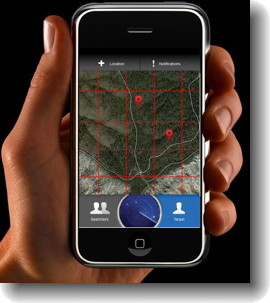Commercial
Locating Radar
During a search and rescue (SAR) crisis, people get separated and due to incapacitation may need to be located by emergency responders. The responders act as a coordinated team in searching through a grid. Locating Radar can be used as online technology by individuals and organizations to assist during the searches. You can use Locating Radar during search activities to provide the locations of all search personnel, team leaders and directors, as well as the locations of the search target(s) or other items of interest.
Use Locating Radar to prioritize and follow the progress in each designated Search Area. Rather than going through the time consuming process of copying and distributing maps, use Locating Radar to automatically create the search areas based on personnel capacity, terrain, and other parameters. The search areas are balanced among members of the search teams and used to track their progress and activity. Locating Radar can also use the Point Last Seen and/or the Last Known Position of the search target(s) as well as other criteria, such as on-site interviews, to refine the search area and render a greater Probability of Detection.
Locating Radar can assist in all of the traditional forms of land field searches - bastard, containment, hasty, grid, choke point and track trap searches.
When a person or other item of interest is located, the location can be documented by Locating Radar by dropping a pin on the current location as determined by GPS. The pin information can be instantly updated with information about the target, such as triaging, requiring immediate medical assistance, debris removal, target extrication, dangerous situations, etc.
The information gathered by Locating Radar in the search field is collectively monitored by the leaders and managers. An instantaneous bird's-eye view of the entire search process is always available to gather facts, access damage, consider probabilities, assess situations, establish priorities, make decisions, develop plans of action, take action, and evaluate overall progress. Locating Radar can be used in real-time to re-purpose the responders in new search areas or to triangulate teams to specific positions.
Locating Radar also ensures the safety of the responders. If a responder runs into trouble and requires help, Locating Radar can instantly send that information and indicate the exact position, time and person requiring assistance.
All progress can be archived so that a post-hoc analysis of the SAR event can be studied for future improvements.
Now part of pTreks
Locating Radar’s search-and-rescue tooling now powers the pTreks platform, expanding its reach from field teams to trail groups and expedition crews worldwide.
Features
- Automatically create and prioritize search areas based on personnel capacity and terrain
- Use the Point Last Seen and/or the Last Known Position of the search target(s) as well as other criteria, such as on-site interviews, to refine the search area and render a greater Probability of Detection
- Assist in all of the traditional forms of land field searches - bastard, containment, hasty, grid, choke point and track trap searches
- Document locations by dropping a pin on the current location as determined by GPS
- Update pin with information about the target, such as triaging, requiring immediate medical assistance, debris removal, target extrication, dangerous situations
- Monitor instantaneous bird's-eye view of the entire search process to gather facts, access damage, consider probabilities, situational assessment, establishing priorities, making decisions, developing plans of action, taking action, and evaluating overall progress.
- Automatically monitor the safety of all team participants all the time.
